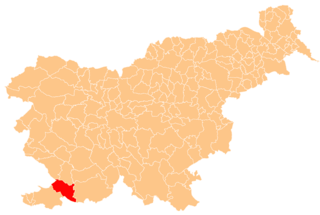| Ocizla | |
|---|---|
 | |
| Coordinates: 45°35′26.17″N13°54′29.29″E / 45.5906028°N 13.9081361°E Coordinates: 45°35′26.17″N13°54′29.29″E / 45.5906028°N 13.9081361°E | |
| Country | |
| Traditional region | Littoral |
| Statistical region | Coastal–Karst |
| Municipality | Hrpelje-Kozina |
| Area | |
| • Total | 3.06 km2 (1.18 sq mi) |
| Elevation | 443.1 m (1,453.7 ft) |
| Population (2002) | |
| • Total | 101 |
| [1] | |
Ocizla (pronounced [ɔˈtsiːzla] ; Italian : Occisla) is a small village in the Municipality of Hrpelje-Kozina in the Littoral region of Slovenia, near the border with Italy [2]

Italian is a Romance language of the Indo-European language family. Italian, together with Sardinian, is by most measures the closest language to Vulgar Latin of the Romance languages. Italian is an official language in Italy, Switzerland, San Marino and Vatican City. It has an official minority status in western Istria. It formerly had official status in Albania, Malta, Monaco, Montenegro (Kotor) and Greece, and is generally understood in Corsica and Savoie. It also used to be an official language in the former Italian East Africa and Italian North Africa, where it plays a significant role in various sectors. Italian is also spoken by large expatriate communities in the Americas and Australia. In spite of not existing any Italian community in their respective national territories and of not being spoken at any level, Italian is included de jure, but not de facto, between the recognized minority languages of Bosnia-Herzegovina and Romania. Many speakers of Italian are native bilinguals of both standardized Italian and other regional languages.

A village is a clustered human settlement or community, larger than a hamlet but smaller than a town, with a population ranging from a few hundred to a few thousand. Though villages are often located in rural areas, the term urban village is also applied to certain urban neighborhoods. Villages are normally permanent, with fixed dwellings; however, transient villages can occur. Further, the dwellings of a village are fairly close to one another, not scattered broadly over the landscape, as a dispersed settlement.

The Municipality of Hrpelje-Kozina is a municipality in the Littoral region of Slovenia. Its main settlements are Hrpelje and Kozina.
The local church is dedicated to Mary Magdalene and belongs to the Parish of Klanec. [3]

Saint Mary Magdalene, sometimes called simply the Magdalene, was a Jewish woman who, according to the four canonical gospels, traveled with Jesus as one of his followers and was a witness to his crucifixion, burial, and resurrection. She is mentioned by name twelve times in the canonical gospels, more than most of the apostles. Mary's epithet Magdalene most likely means that she came from the town of Magdala, a fishing town on the western shore of the Sea of Galilee.
A parish is a territorial entity in many Christian denominations, constituting a division within a diocese. A parish is under the pastoral care and clerical jurisdiction of a parish priest, who might be assisted by one or more curates, and who operates from a parish church. Historically, a parish often covered the same geographical area as a manor. Its association with the parish church remains paramount.

Klanec pri Kozini is a settlement south of Kozina in the Municipality of Hrpelje-Kozina in the Littoral region of Slovenia.
The Italian writer Scipio Slataper wrote his masterpiece Il mio Carso (My Karst) in Ocizla.
Scipio Slataper was an Italian writer, most famous for his lyrical essay My Karst. He is considered, alongside Italo Svevo, as the initiator of the prolific tradition of Italian literature in Trieste.
Between 1933 and 1940, a cell of the anti-Fascist insurgent organization TIGR was active in the village.

TIGR, an abbreviation for Trst (Trieste), Istra (Istria), Gorica (Gorizia) and Reka (Rijeka), full name Revolutionary Organization of the Julian March T.I.G.R., was a militant anti-fascist and insurgent organization established as a response to the Fascist Italianization of the Slovene and Croat people on part of the former Austro-Hungarian territories that became part of Italy after the First World War, and were known at the time as the Julian March. It is considered one of the first anti-fascist resistance movements in Europe. It was active between 1927 and 1941.











